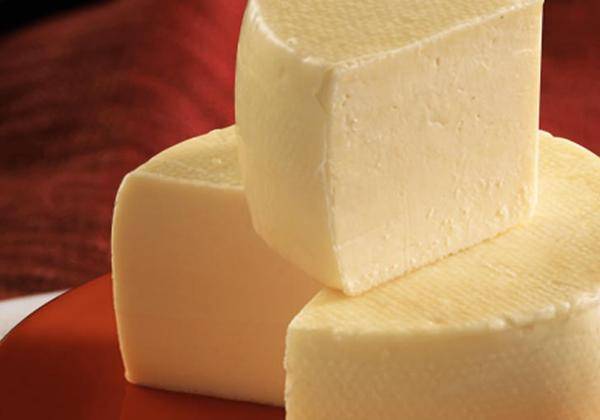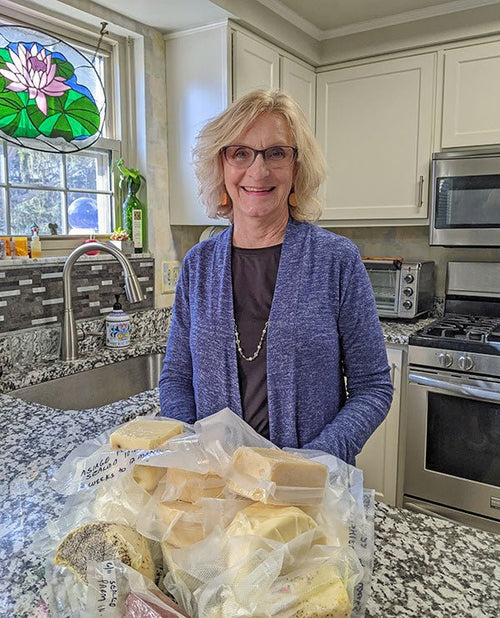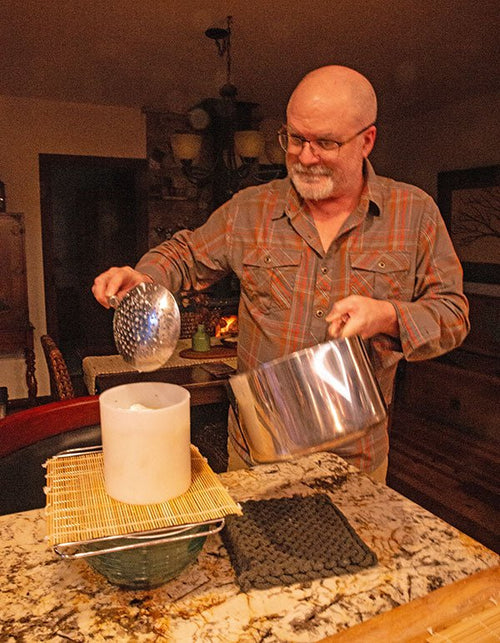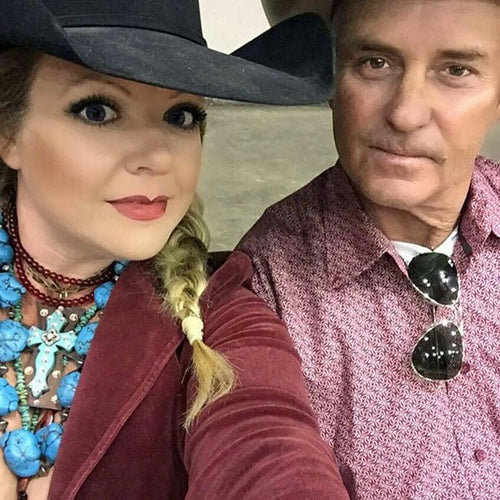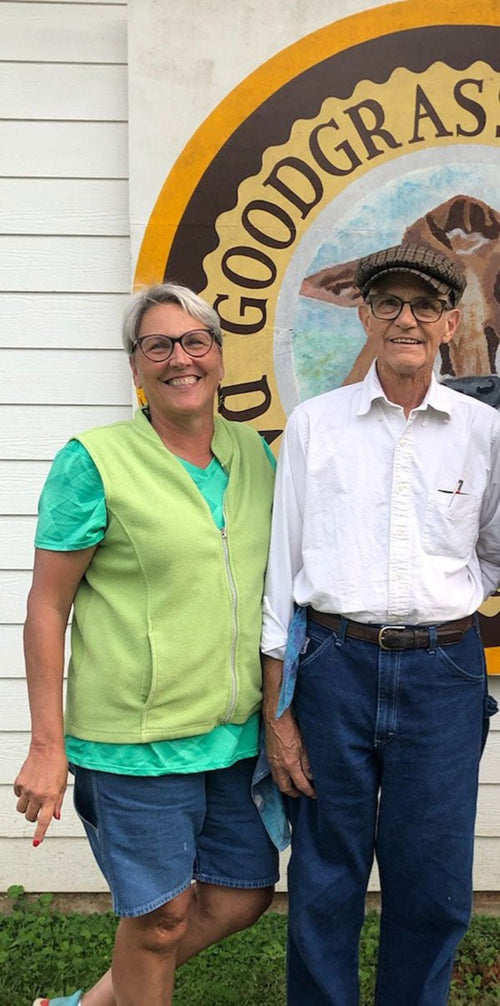Cheese Making Recipe of the Month
Paneer
Vegetarians - check this out! This is a mild, versatile cheese with no rennet.
In fact, the only ingredient you may not already have in your kitchen is citric acid. (You can use vinegar or lemons, but citric acid is the most reliable and consistent.)
When you make and eat your paneer, you will be in good company because this is the most popular cheese in India and Southern Asia.
It's popular because it's very easy to make and it doesn't melt when heated. So, it can be fried (as in stir-frys), barbecued (as in shish kabobs), boiled (as in sauces), etc, etc.
Beginners - it's a new year and this is your whey to start an exciting adventure into the world of home cheese making. We promise you won't regret it!
Cheese Making Questions & Answers
Excess Mold?
Q. My cheddar, aging in the cellar for a little over one month, has what appears to me to be a great abundance of mold on it. It is the only cheese down there. The shelf, made from kiln-dried pine, also has a lot of mold on it.
The temperature is approximately 60F and the humidity is ranging from 85-90%. There is no artificial temperature/humidity control. Is this good, bad, indifferent? Should I be doing anything more/less like washing the mold off or what?
A. I would suspect that the moisture is much higher than you are reading. Make sure you have an accurate hygrometer. We normally target 80-85% moisture here. Also, if there is no air movement, more mold will grow. You need the air moving slightly and you need to turn the cheese often and wipe the mold off. The shelf needs to be kept clean as well.
Plastic Coating
Q. I have a couple of cheddar wheels that seem to be gassing up in the center. This is the first time. I coat each wheel with plastic cheese coating.
Just wondering if I’m not pressing long enough? I also wonder if I need to break up my curd more before putting it in the molds? I have made 10 batches of cheddar and this is the first time.
A. Internal gas can be a problem from many sources. You can be picking up some Butyric bacteria in the milk, or even some Propionic.
If you cut into your cheeses, you should find a lot of information. Butyric would be late gas and splitting right down the center. Propionic would be many smaller, shiny holes (swiss). If you have a ton of small holes, this could be coliform. The smell can also be a tip-off.
It could also be a matter of molding too early and at too high a pH. This may have been an ongoing problem, but the gas was able to escape through the rind. When you began using the plastic coat, it trapped the gas internally.
We are not big fans of the plastic coats. We have seen many previously great cheeses lose their standard with this application. Its use seems to be intended as a shortcut to reduce work in the aging space and lessen the need for moisture control.
Little White Balls
Q. I’ve been making traditional cheddar. Some of the wheels develop little white balls in the cheese. Do you know what causes this? I’ve attached a picture (at left).
A. Those bits are called tyrosine, and they're actually amino acid clusters that form with age. Tyrosine clusters are signs of a well-aged cheese.
Tyrosine is a non-essential amino acid found mainly in casein, the dominant protein found in milk. The word itself is from the Greek tyros, meaning cheese.
The fats and proteins in a young cheese are trapped within the protein matrix that formed during acidification. This is essentially the curd structure. Then, when cheese undergoes extensive aging, these protein begin to change, leaving the characteristic tangy, hard little bits. As cheese ages, the protein chains begin to deteriorate, leaving pockets of tyrosine behind.
Here's more info:
From the Savenor's Market website:
The delectable crunch of these tyrosine pockets is their most obvious benefit, but there is also evidence that they play a role in boosting your mood. In the olfactory bulbs of the brain, which are responsible for detecting odors and taste, tyrosine reacts with an enzyme called tyrosine hydroxylase.
These reactions produce several neurotransmitters, including epinephrine (adrenaline), norepinephrine, and dopamine, all of which have profound effects on mood. Epinephrine boosts the flow of oxygen and glucose to the brain. Norepinephrine affects the amygdala, a part of the brain associated with memory and emotional reactions; it plays a large role in attention and focus, and helps ward off depression. Dopamine is a crucial component of the brain’s reward system, which is responsible for providing feelings or pleasure or reinforcement. Put all that together, and it’s easy to see how eating cheese can actually make us feel happy.
Can yogurt and /or cheese be made from dry milk?
Q. I am getting ready to go visit my daughter who works in an orphanage in Nigeria. She has been there awhile and is seriously missing all dairy products. The only reliable source of milk they have is dry milk. Can yogurt and /or cheese be made from dry milk?
A. Dry milk powder works fine, but it needs to be nonfat. Then, you will either make a very lean cheese; or add some fresh cream to the reconstituted milk before making the cheese.
The fat in dry milk tends to go rancid. Cheaper versions of milk coming in from Asia are tending to be higher heat drying and are problematic. Pack along a box of 'Carnation' brand if you just want to make a basic cheese, but I would try it at home first.
All in all, if you do not have access to good milk, the cheese may not be a qualifier for greatness. If your daughter is outside of the urban areas, there may be local milks in the marketplace. Have her ask around. The big cities pretty much have nothing workable there for fresh milk.
Lactose Intolerance
Q. I am lactose intolerant, but miss having cheese. I recently made some yogurt with a culture from the health food store using lactose free milk. I was wondering if that could be done with cheese? I would also like to know if cheese can be made with milk substitutes such as almond milk and coconut milk?
A. The yogurt worked with this milk primarily because the thickening agent is not the normal cheese protein but is, instead, whey proteins.
Lactose free and other alternative milks will not work for cheese making unless a substitute food for the bacteria is added. The process of cheese making is based on converting lactose in milk to lactic acid. This process drives the conversion of liquid milk to curds, which eventually becomes cheese.
The conversion also causes the moisture to be released. Without lactose in milk there is no food to support the bacterial cultures. The real problem is that these added sugars will then need to be reinforced with thickeners and other additions which we do not see as fit for a healthy product.
For those suffering from lactose intolerance, the following info should help:
A cup of cow's milk contains about 10-12 grams of lactose. The bacteria used to produce cheese and the time required for cheese to ferment, both work to lower lactose levels. Soft cheeses typically have only half as much lactose as the milk they are made from, and sometimes even less. Aged cheeses, including most hard cheeses, have less lactose still. For example, an ounce of Swiss cheese or cheddar cheese typically has less than one gram of lactose - a safe level of lactose intake for most individuals, even those who are lactose intolerant.
If you would like to explore vegan cheese making without the cheese proteins or lactose, we carry a great book - Artisan Vegan Cheese.
Have a cheese making question, we're here for you: info@cheesemaking.com
Meet a Fellow Cheese Maker
Joy Metcalf
Making Caciotta with Saffron
I was interested to see the recipe for Caciotta cheese in the recent newsletter.
I've been making Caciotta del Filetto Rosso for several months now, and I love this cheese.
I got it off cheeseforum.org, and it's truly one of the best cheeses I've found. The recipe calls for a mixture of cow and sheep milk, but I use raw goat's milk.
The cheese has a smooth taste and a wonderful flavor! I have three in my cheese cave right now. I've never let them age beyond 3 months because goat's milk cheeses seem to age faster, but at three months, the taste is divine.
Joy Metcalf, Northport, Maine
News From Fellow Cheese Makers
Making Cheese & Losing Weight
I'm a home cook who's lost over 130 pounds between 2005-2007 thanks to cooking. Exercise was key too. But I taught myself how to cook healthy versions of my favorite foods as I exercised. It took 17 months.
I've wanted to make fresh cheese since, but never did. You know how it goes - sauces, pastas, pies - no cheese.
Well, I was Christmas shopping and came across a kit for making your own cheese. Rennet, citric acid, thermometer included. Perfect. I grabbed it. I made the cheese according to the directions provided but, to be honest, it left something to be desired.
I found your site through a Google search, instantly loved the recipe, and pulled it off. And let me tell you: it was outstanding. The cheese was perfectly formed, perfectly textured, and absolutely delicious. I'm making more next weekend!
Pete Simone, Yonkers, New York
Please send your cheese making news & photos to: moosletter@cheesemaking.com






























